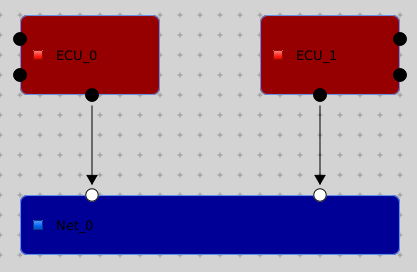Generic Platform Architecture
The generic platform architecture is a simple flat platform architecture that abstracts distributed systems consisting of networked ECUs (electronic control units). It can be used to generate platform-independent code, and for basic design-space exploration tasks.
The generic platform consists of execution and transmission units, e.g., ECUs and busses (depicted by the boxes). ECUs and busses are connected with each other by controllers (depicted by bullets and the directed arrows). ECUs can also have sensors and actuators, which model input and output hardware, which is connected to the execution unit directly, e.g., digital I/O, PWM, ....
- Generic ECU: A generic ECU is an abstract execution unit, which is programmed in C. It may have generic sensors, actuators and bus controllers.
- Generic Bus: A generic bus is abstract transmission unit, which is not detailed any further. For the generic architecture it is used to model the network topology.
- Generic Actuator: A generic actuator is abstract actuator, which is given as a header and a implementation file. The specifics of the hardware abstraction are not detailed any further. A generic ECU can have more than one generic actuator with distinct names.
- Generic Sensor: A generic sensor is abstract sensor, which is given as a header and a implementation file. The specifics of the hardware abstraction are not detailed any further. A generic ECU can have more than one generic sensor with distinct names.
- Generic BusController: A generic controller is abstract bus access unit, which is given as a header and a implementation file. The specifics of the hardware abstraction are not detailed any further. A generic ECU can have more than one generic controller with distinct names.
The following picture shows an example for a platform with two generic ECUs with two button (sensors) and two lights (actuators) and a generic network in between.
